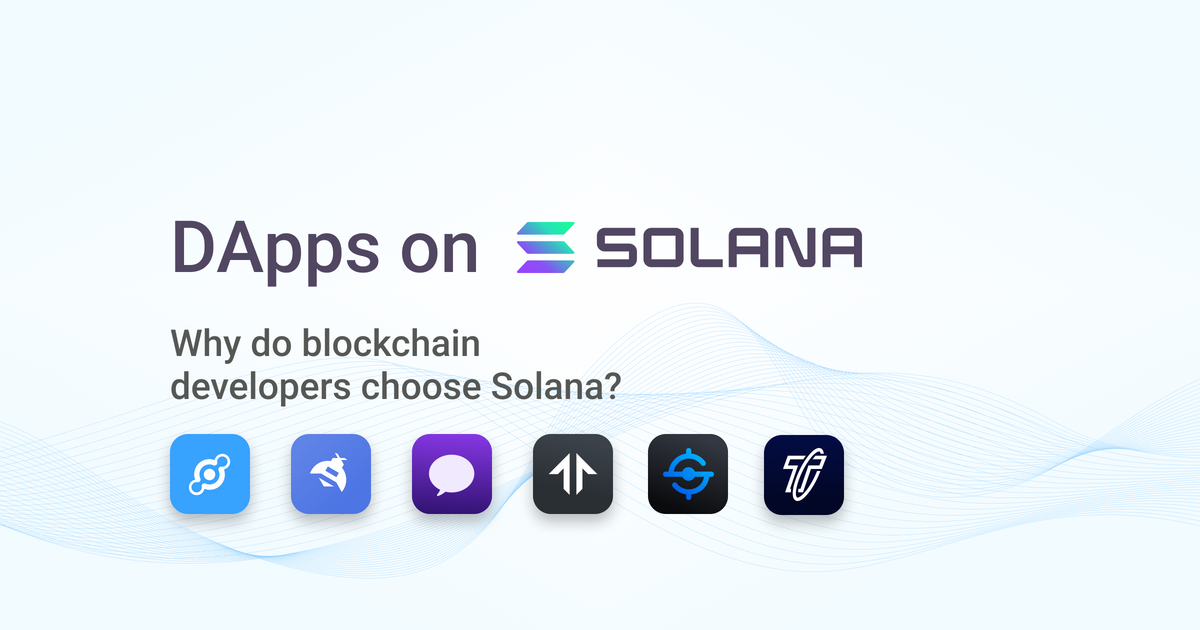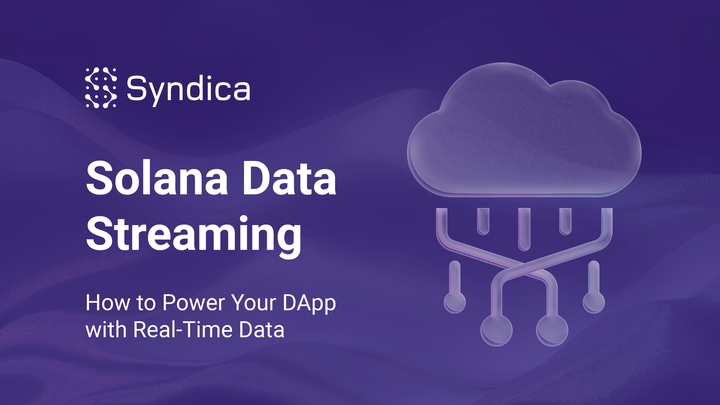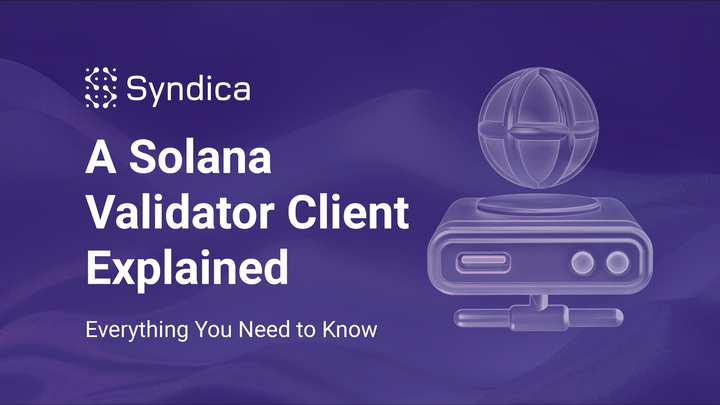DApps on Solana
Decentralized applications, or DApps, have become a prominent feature in the blockchain ecosystem.

Why Do Blockchain Developers Choose Solana?
Decentralized applications, or DApps, have become a prominent feature in the blockchain ecosystem. These applications leverage the benefits of blockchain technology, such as transparency, immutability, and security, to provide users with a decentralized and trustless experience. Solana, a high-performance blockchain, offers developers a robust infrastructure layer to build and deploy DApps. In this article, we will explore what DApps are, how they work on Solana, the benefits of building DApps on this blockchain, and the notable projects and resources in the Solana ecosystem.
What are DApps?
Decentralized applications, or DApps, are applications that run on a decentralized network of computers, rather than a single central server. These applications leverage blockchain technology to provide transparency, security, and immutability. Unlike traditional applications, DApps are not hosted by a single entity, making them resistant to censorship and single points of failure.
How DApps Work on Solana
Solana provides a high-performance blockchain platform that enables the development and deployment of scalable DApps. It utilizes a unique set of features and mechanisms to achieve high throughput and low latency.
One of the key features of Solana is its proof-of-history (PoH) consensus mechanism. PoH establishes a secure and cryptographic source of time throughout the network, eliminating the need to trust timestamps from other nodes. This mechanism allows Solana nodes to generate blocks sequentially, without the need for prior alignment with the network.
The effective operation of DApps on the Solana blockchain heavily relies on the Solana runtime. This essential component facilitates the execution of smart contracts and operates as a real-time transaction processor. It effectively decouples program code from its operational state, allowing for parallel execution of transactions involving read-only accounts, while transactions that involve writable accounts are processed sequentially. Interaction between the runtime and the program occurs via a defined entry point interface.
Solana also employs a block propagation protocol called Turbine. Turbine splits blocks into small packets during transmission, simplifying data transmission between nodes. This protocol is independent of the consensus mechanism, further enhancing the scalability and efficiency of DApps on Solana.
Another important feature of Solana is the Gulf Stream mechanism. Gulf Stream minimizes transaction delays and reduces the number of transactions in the “mempool” section (technically, Solana does not have a mempool). By pushing transaction caching and forwarding to the periphery of the network, Solana enables validators to process transactions instantly, improving the overall speed of a DApp's functioning.
Additionally, Solana utilizes a pipeline for transaction processing and optimization. This CPU design allows for fast transaction validation and processing between nodes, further enhancing the efficiency and speed of DApp processes.
Benefits of Building DApps on Solana
There are several benefits to building DApps on Solana:
1. Scalability: Solana's unique features and mechanisms enable high throughput and low latency, making it highly scalable. This scalability allows DApps built on Solana to handle a large number of transactions without compromising performance.
2. Speed: Solana's high-performance architecture ensures fast transaction processing and validation. This speed is crucial for DApps that require real-time interactions and responsiveness.
3. Low fees: Solana offers low fees, making it cost-effective for users to interact with DApps. This affordability encourages user adoption and engagement.
- Instead of a global fee market used on Ethereum, (since Solana defines the state in which programs are used) Solana is able to utilize state-localized fee markets, where protocols that cause congestion (e.g. a popular NFT mint) require a higher fee, but the rest of the network maintains a stable fee (See Figure 2. of the Visa article).
4. Security: Solana's consensus mechanism, cryptographic protocols, and runtime architecture provide a secure and tamper-resistant environment for DApps. The decentralized nature of Solana ensures that no single entity has control over the network, reducing the risk of attacks and data breaches. Solana also publicly publishes security audits of the blockchain protocol and programs.
5. Interoperability: Solana provides interoperability through a unique bridging protocol called Wormhole. This protocol allows for seamless integration and communication between different blockchain networks, expanding the possibilities for DApp development.
Notable Projects and Resources in the Solana Ecosystem
The Solana ecosystem offers numerous resources for developers, including:
1. Solana Developers: Solana Developers is a resource provided by the Solana team for developers interested in learning about and building on the Solana blockchain platform. The website provides a wealth of information and resources, including documentation, tutorials, and community support.
2. Solana Docs: Solana Docs is a collection of resources and documentation provided by Solana. It consists of the platform's features, technical details, and guides on how to build and deploy DApps on Solana.
3. Solana Cookbook: Solana Cookbook is a developer resource that provides information and examples for building applications on the Solana blockchain. It is organized into different sections that cover core concepts, guides, and references for Solana development.
These projects and resources in the Solana ecosystem provide opportunities for collaboration, learning, and support for developers looking to build DApps on Solana.
Real-World Examples of Successful DApps on Solana
To showcase how Solana's unique features and mechanisms have been utilized to create practical and impactful applications, let's explore some notable DApps built on Solana:
STEP’N
STEP’N: STEP’N is a smartphone app that incentivizes physical activity such as walking, jogging, or running by offering users the opportunity to earn tokens through a gamified fitness experience. It introduces a move-to-earn model via the Solana blockchain, encouraging healthier lifestyles while providing an accessible entry point to the world of crypto and NFTs.
Hivemapper
Hivemapper: Hivemapper introduces a collaborative approach to map creation, likened to a beehive where people collectively contribute to building detailed maps. Participants use dashcams to capture images, and some act as AI Trainers, teaching computers about the world from these images. In return for their efforts, contributors receive digital tokens called HONEY, which can be traded for valuable map data on the blockchain-powered platform.
Metaplex
Metaplex: Metaplex empowers artists and creators to effortlessly launch their own NFT storefronts akin to building websites, offering rapid NFT creation and minimal minting fees. Metaplex is comprised of on-chain programs and a web application, forming a network of contracts for NFT creation, auctions, and visualization, and serving as a go-to solution for NFT development and community engagement within the Solana ecosystem.
Helium
Helium: Helium operates a decentralized blockchain network using Hotspots as nodes to connect wireless devices to the internet with extended range and efficiency. By utilizing its native token HNT and novel Proof of Coverage, Helium facilitates a global network for connectivity, offering an innovative and cost-effective solution for wireless infrastructure expansion. Thousands of existing devices and sensors can be easily configured to run on both the Helium cellular and global LoRaWAN (Long Range Wide Area) networks.
Marginfi
Marginfi: Marginfi is a decentralized margin protocol on Solana, offering traders a unified platform to access margin, manage risk, and optimize capital efficiency. It prioritizes risk management, enables transparent and secure lending, and uniquely supports collateral from third-party protocols, enhancing accessibility and flexibility for users seeking leverage within the Solana ecosystem.
These examples demonstrate how Solana's unique features - like high scalability, speed, low fees, security, and interoperability - have been leveraged to create successful and impactful DApps.
Syndica empowers principal enterprises and architects advancing the Solana ecosystem. In building the Cloud of Web3, we provide best-in-class RPC node infrastructure, Developer APIs, a robust end-to-end platform, and the next cutting-edge Solana client validator, ‘Sig’, written in Zig. Our team offers the dedicated support, reliability, and user-focused orientation for seamless integration with Solana, allowing you to focus solely on building your enterprise.
Power your enterprise using Syndica. Get started quickly today for free at www.syndica.io and check out our documentation here.



